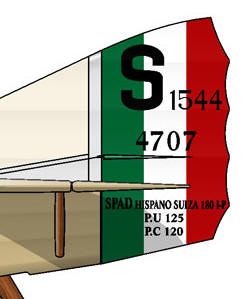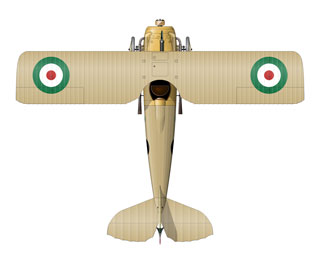Camouflage & Markings
by Tomasz Gronczewski
Giorgio Pessi – An Ace Disguised
The Italian Ace Giorgio Pessi was born on November 17th 1891 in Trieste, a city belonging to Austro Hungarian empire. He was an Italian, and found himself in very disadvantageous situation when AH empire and Italian kingdom became hostile countries. In January 1915, four months before the countries started to fight against each other, he decided to escape to Italy and made his trip to Venice. After a Great War reached Alps he volunteered in the Italian cavalry. He was enlisted in the famous ”Piemonte Cavalleria” Regiment, where future Italian ace of aces Francesco Baracca was also serving. But soon gods of air chose young Giorgio Pessi and tempted him to enrol flying course. In October 1916 he became a pilot and started to teach younger pilots.
On May 3rd all Italian irredentists serving within military formations were ordered to change their names in order to avoid any troubles that might arisen with their families living in enemy countries. Thus Giorgio Pessi has been known as Giuliano Parvis since then.
On May 25th he started his true air combat career as he was assigned to 78a Squadriglia flying Nieuport scouts. His skills must had been very good, as on July 15th he was moved to elite 91a Squadriglia, one of most famous Italian outfits ”populated” by such aces like Francesco Baracca (34 victories during Great War), Pier Rugero Piccio (24 victories), Fulco Ruffo di Calabria (20 victories), Ferrucio Ranza (17 victories), Luigi Olivari (12 victories). He proved that confidence showed toward him was well-founded, and he dispersed two enemy aircraft yet in the 30th of July, and shot down an Albatros two-seater in the beginning of August.
His score grew up steadily and his finest day came on November 6th. On that day he downed one two seater and one scout identified by him as Berg, but probably being Albatros D.III Oeffag 153.54 flown by an AH ace Freiherr von Szepessy Sokoll who had scored five victories. The Hungarian aristocrat was found dead in his Albatros near Latisana.
Parvis vel Pessi was awarded with Medaglia d’Argento al Valor Militare for his four victories scored so far. Before the year ended he had scored further two victories and was awarded with the same medal for military gallantry again. Anyhow on March 15th he was ordered to leave 91a Squadriglia as all irredentists were forced to leave frontline units. He returned to instructor duties and became Caproni’s test pilot.
After the Great War had ended, Giorgio Pessi sailed to USA, to demonstrate Caproni Ca 5 capabilities. He must have been very convincing when he was flying the aircraft under Brooklyn bridge. Later he demonstrated Caproni plane in various European capital cities until 1922, when he decided to leave army and to make a business out of his flying skills. He sailed to Anatolia and he founded a flying school there. Soon he joined Società di Navigazione Aerea Aero Espresso Italiana of Genoa and flew Marina Fiat Wal hydroplanes over Mediterranean sea. Despite he was appointed as a general manager of Brindisi – Athens – Rodi – Constantinople line, he never stopped flying. He died on July 18th 1933, when his Marina Fiat Wal sunk into the sea somewhere between Athens and Rodi. His plane was never found despite careful searches.
Giorgio Pessi’s victory list
Some of Giorgio Pessi’s victories were unconfirmed and thus not counted, although evident victory over Szepessy-Sokoll fell into that category too. The list of Pessi’s victories was based on www.theaerodrome.com, but according to Alberto Casirati some of details are different. In order to highlight differences I marked aerodrome version with green, and Alberto’s with red when information varied. Also this time I used border lines because the table seemed to be somehow sophisticated
| Vic. |
Date |
Time | Victim | Victim id. | Unit | A/C flown | Place | Comments |
| 1 |
2/08/17 |
08:30 | two-seater (Brandenburg C.I or Albatros) |
91a Sq. | Spad 7 S.4690 |
Ovcia Draga | together with Ferrucio Ranza |
|
| 29/09/17 | 10:40 | Brandenburg C.I | 91a Sq. | Spad 7 | Pietra Rossa Lake | |||
| 2 | 26/10/17 | 11:15 | German two-seater (DFW C.V) |
91a Sq. | Spad 7 | Clabuzzano | ||
| 3 | 26/10/17 | 12:00 | German two-seater (DFW C.V) |
91a Sq. | Spad 7 | South of Piero Natisone |
together with Francesco Baracca |
|
| 6/11/17 | 10:30 | single seater (Albatros D.III or Berg) |
If true, Szepessy Sokoll’s 153.54 |
91a Sq. | Spad 7 | Fossalta | ||
| 4 | 6/11/17 | 11:00 | two seater (DFW C.V) |
91a Sq. | Spad 7 | Godega, South of Urbano |
||
| 5 | 6/11/17 or 7/11/17 |
11:45 | two seater (DFW C.V) |
91a Sq. | Spad 7 | Near Orsago | ||
| 6 | 6/11/17 or 23/11/17 |
German two seater | 91a Sq. | Spad 7 | Mt. Franchin/ Moncader |
Pessi’s Aircraft
During his brief service within 78a Squadriglia Giorgio Pessi flew Nieuport 11, which cowling was divided into red, white and green segments.
After he moved to 91a Squadriglia he was assigned with a personal Spad VII (French number S.1544 / Italian number 4707). I don’t know if he used this plane to score any of his kills (First successful aerial combat on July 30th 1917, when he dispersed two E/A was done with 4699, and his first confirmed victory was scored when flying 4690).
Pessi’s regular Spad VII carried typical French yellow finish. Metal surfaces were painted with chrome yellow lacquer (based on lead chromate PbCrO4 pigment), and fabric surfaces were painted with chrome yellow cellulose lacquer with an addition of aluminium powder. The latter mixture (58% of lead chromate versus 42% of aluminium powder) was subtly darker, less vivid and a bit greener than pure ”metal” version of chrome yellow. The effect was amplified by the poor quality of aluminium powder which was greyer and less shiny than it is nowadays.
A starboard of this Spad was almost perfectly symmetrical:
Spad VII no. 4707
91a Squadriglia
Pilot Giorgio Pessi
Autumn 1917
Green / white / red roundels were painted on both fuselage sides, and they were of ”Italian” proportions (green 60cm, white 38cm, red 16cm). The rudder carried standard Italian flag with typical inscriptions. Black moon behind the roundel was Giorgio Pessi’s personal badge. It seems that the diameter of the moon was 60cm, just like the national insignia.
Note that the vertical stabilizer had been probably damaged, because its fabric was replaced with clear doped linen. Also note that there was usual natural metal stripe before rudder and natural metal triangle in the bottom part of the stabilizer.
A close-up of the rudder shows arrangement of inscriptions, but I am not fully sure about the type description in the bottom part of the rudder. It was obviously present, but I am not certain about exact weights written.
The top profile shows roundels carried by Pessi’s Spad, which were much smaller than French insignia, but were standard among Italian Spads. The diameter of the roundels was 100cm, and their proportions was similar to those painted on fuselage. Bottom surfaces of both wings carried typical Italian markings: red port wing tips and green starboard wing tips.
Because of common usage of orthochromatic films the colour relation may have looked totally different on black and white photos. A reduced sensitiveness of chromate compound based film on chromate compound based paints may cause the effect of darker looking cowling versus lighter fabric surfaces. I tried to simulate this effect below:
This article was originally published in IPMS Stockholms Magazine in November 2005




